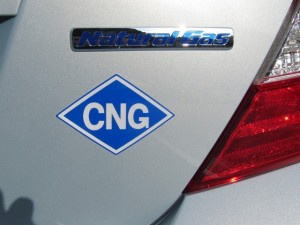The high cost of gasoline is not just a problem for each of us as individuals; it is a problem for our society as a whole. The entire economy, both nationally and internationally, has become so dependent on fossil fuel-based transportation that serious sustained increases in petroleum costs could cause a worldwide depression and in some places even societal collapse. Our nation’s existing transportation infrastructure and the zoning laws that have shaped our development patterns were put in place on the assumption that cheap fuel prices would last forever, and the result is that the United States has become more dependent on the internal combustion engine than any other nation on earth. So when $6 a gallon gasoline does finally come – and a war in the Middle East involving Iran could be just the shock to the system that will bring it about – this country will be uniquely unprepared to handle it.
 While it may not be ready soon enough to protect the American nation from severe economic disruption, fortunately there is a transportation alternative that should give us hope for the future. Compressed natural gas is a type of fossil fuel capable of powering the internal combustion engine at a significantly cheaper cost than gasoline, and domestic supplies alone could keep American cars, trucks, buses, and trains running well into the next century.
While it may not be ready soon enough to protect the American nation from severe economic disruption, fortunately there is a transportation alternative that should give us hope for the future. Compressed natural gas is a type of fossil fuel capable of powering the internal combustion engine at a significantly cheaper cost than gasoline, and domestic supplies alone could keep American cars, trucks, buses, and trains running well into the next century.
Right now, there are more than 12 million vehicles on the road world wide that are running on compressed natural gas (CNG), either exclusively or as a part of bi-fuel systems that burns CNG and gasoline together. These vehicles are only beginning to show up in the United States, but nevertheless they are here, and anyone interested in the possibilities offered by alternative fuels in general should investigate this potentially exciting automobile technology.
Compressed Natural Gas Vehicles – Key Facts
Compressed gas is concentrated natural gas that has been squeezed down to about 1 percent of its normal volume, which causes its pressure to rise to approximately 3600 psi. When used as fuel for automobiles, CNG is kept in strong metallic cylinders that are usually placed in the trunk on gasoline/CNG bi-fuel automobiles, or underneath the body of the vehicle on cars that use only CNG for fuel. Delivery from fuel tank to engine is controlled by a fuel regulator, which reduces psi from 3600 down to a more usable 125 before the CNG is injected into the combustion system. In bi-fuel vehicles, the gasoline and compressed gas tanks are a part of separate fuel systems, and it is necessary to flip a switch to change from one tank to the other.
CNG-powered vehicles can be refueled at natural gas stations, or they can be filled up at home with specially-constructed compressor pumps that take natural gas delivered for home residential use and pressurize it the levels required for use in an automobile. At the present time, costs for compressed gas purchased at a refueling station run from a low of about 90 cents per gasoline gallon equivalent (gge) in Utah, where the stations are subsidized by the state, to the $1.50 – $2.50 gge range in other locations. Unfortunately, because CNG-powered vehicles are still rare in this country, there are only 941 refueling stations open in the entire U.S., mostly in New York, California, Utah, and Texas.
Available Options
While several automakers are producing compressed gas vehicles for international markets, the only passenger car currently available from dealers in the United States is a CNG version of the Honda Civic GX, which carries a suggested retail price tag of $26,000. Even though this it the only retail option available right now, however, that will be changing very soon. In addition, the government does purchase a number of CNG-powered cars and trucks, and these can sometimes be bought used at government auctions. The only problem is that because the cost of compressed natural gas fuel is so low, these vehicles are in high demand, and the bidding can push the prices of these vehicles to levels significantly above retail costs.
The good news is that many classes of cars and trucks have been approved for retrofits. Theoretically, any automobile that runs on an internal combustion engine can be turned into a bi-fuel car, and most of the CNG vehicles that are currently on the roads in the United States originally ran only on gasoline. Nevertheless, there is one big limiting factor here, and that is cost. Anyone hoping to have their car converted to a gasoline/CNG hybrid should expect to pay somewhere between $6,000 and $18,000 to have this done, with the high-end cost being much more likely. This is because any class of car approved for retrofit that has onboard diagnostics – which is basically any car produced in the last ten years – must have a system installed that is sophisticated enough to meet either EPA certified standards or the even more difficult-to-achieve California Air Resources Board (CARB) requirements. With older cars, it might be possible to keep costs down somewhat by installing something non-certified, but an older car may not have enough miles left in it to justify the expense of such an investment. The federal government does have tax credits that can help cover the costs of a conversion, but these are only available with the installation of a more expensive system that meets EPA standards.
These conversion costs are obviously a big reason why CNG-powered vehicles are not taking off in the United States, despite the amount of money they can potentially save on fuel costs. Even in countries that allow non-certified conversion systems to be installed the costs are keeping CNG from penetrating the passenger car market more deeply, and at the present times bus and taxi fleets are the primary purchasers of bi-fuel or exclusively CNG vehicles both here and abroad.
Doing It Yourself?
Because Clean Air Act statutes prohibit the at-home modification of fuel systems, anyone planning to convert their car to a bi-fuel setup will need to have the installation performed by a certified compressed natural gas installer. Presumably, a person who doesn’t worry about taking the risk could try to install a system themselves, but anyone caught driving a car with a fuel system they modified on their own could be subject to a fine of $5000 for each day spent on the road. Also, while it might be possible to get away with a do-it-yourself system (and kits are available for sale over the internet), a poorly installed engine could cause a car to malfunction and break down, and of course natural gas is capable of exploding or catching on fire if handled improperly, so it may not be the sort of thing anyone should be fooling around with on their own anyway. The kinds of kits available online are of the non-certified variety in most instances, so unless they were being installed on an older car, it could be hard to find a certified mechanic willing to put them in.
A Solution to Our Problems?
At the present time, the CNG car market is still very much in its nascent stages. Because the fuel is cheap and available domestically, making the switch to natural gas could save us all a lot of money in the long run, as drivers would be paying less for fuel and taxpayers would no longer be asked to fund foreign wars designed to secure access to oil supplies in the Middle East. But at least for now, purchasing a new or used CNG-powered Honda Civic GX or one of the new CNG vehicles that will soon be released or hoping against hope that a good bargain can be found at a government auction is probably a much better solution than trying to pay for the costs of a conversion. We can only hope that as the technology advances costs will come down far enough to make compressed natural gas the true wave of the future.
©2012 Off the Grid News
 Off The Grid News Better Ideas For Off The Grid Living
Off The Grid News Better Ideas For Off The Grid Living




